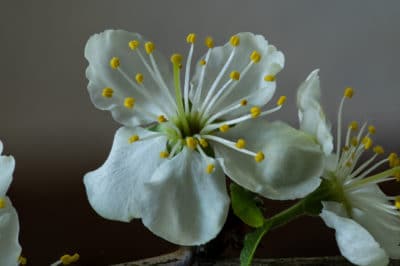Problems with Plum Tree Flowering and Fruiting
Plum trees can fail to bloom or form fruit for any of the following reasons:
- Insufficient chill –hours,
- Lack of pollinator tree nearby,
- Insects and disease,
- Incorrect pruning and fertilizing.
Chill Hours: Each variety has its own requirement for hours below 45ºF (7ºC), known as dormancy. Dormancy resets the tree for a renewed cycle of growth, flowering, and fruiting. If the tree breaks dormancy and blooms at the wrong time and flower buds or petals encounter freezing conditions, blossoms fall and fruit does not appear.
Pollination: Most varieties of plum are not self-fertile, and they must have another tree of a different variety nearby. The pollinator tree must be in the same group of Japanese or European plum, and not all varieties can cross-pollinate within their own group.
Shortly after blossoms drop, you can determine whether or not the flower set fruit. Look closely at the ovary of the flower remaining on the tree where blossoms have dislodged. If the ovary is swollen, a fruit has set and is starting to grow and pollination was successful.
Insects: Insects such as plum circulio and aphids can eat at tender buds and shoots, reducing or eliminating flowers or small fruit.
Cultivation: Too much nitrogen fertilizer causes trees to increase production of leaves and shoots at the expense of flowers and fruit. Improper pruning can also damage or remove budding branches needed for flowering and fruiting to occur.
Solutions for Plum Blossom Problems
If you are planting a new plum tree, select a location well protected from frost, wind, and soggy soils. This will help assure that future blossoms have the best chance of turning into abundant fruit harvests.
Contact your local Agricultural Extension Office for information about average chill hours for your area. Choose trees with chill-hour requirements matched for your location.
Plant more than one tree, unless you are planting one of the less common self-fertile plums. Even self-fertile plums are more productive with a pollinator nearby. Check that the varieties you are planting are compatible for cross-pollination.
Watch for pests and take action as soon as you see troublesome insects or symptoms. Taking action against pests early in an infestation makes it easier to use milder remedies, avoiding injury to other wildlife or people with toxic controls.
Keep in mind that plum trees do not bloom in the first years after they are planted, and old trees can get too old for flowering.
